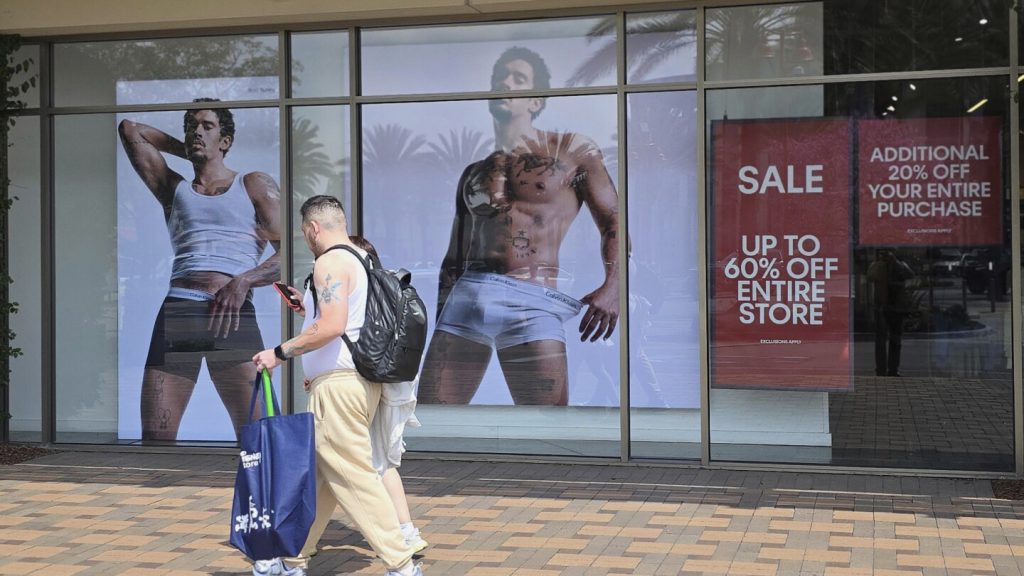WASHINGTON (AP) — U.S. inflation likely picked up a bit last month as President Donald Trump’s tariffs start to bite, but lower prices for gas and possibly for air fares and used cars may limit the overall increase.
The government’s inflation report, to be released Wednesday, is forecast to show that consumer prices rose 2.5% in May compared with a year ago, according to economists surveyed by data provider FactSet. That would be the first increase in four months and up from 2.3% in April. Excluding the volatile food and energy categories, core prices are projected to have risen 2.9% in May from a year earlier, up from 2.8% in April.
Trump’s tariffs are expected to contribute to the uptick by raising the cost of some imports, including clothes, furniture, appliances, and possibly new cars. Many retailers and some consumer products companies have said they have plans to raise prices or have already done so to cover the cost of the import duties.
On a monthly basis, prices are expected to have moved up 0.2% from April to May, while core prices are forecast to have increased 0.3%. At that pace, core prices would rise much faster than the Federal Reserve’s 2% target. Economists and the inflation-fighters at the Fed focus on core inflation because it often provides a better sense of where inflation is headed.
Inflation has cooled in the past year and, excluding the impact of tariffs, economists say it would be on track to return to the Fed’s target, which would allow the central bank to cut its key interest rates. Yet core prices have been more stubborn and were stuck between 3.2% and 3.4% for nearly a year until February, when they started to decline a bit.
Last week, the Labor Department’s Bureau of Labor Statistics, which compiles the inflation data, said it is reducing the amount of data it collects for each inflation report. Economists have expressed concern about the cutback, and while it isn’t clear how sharp the reduction is, most analysts say it is likely to have a minor impact. Still, any reduction in data collection could make the figures more volatile.
Nearly all economists expect Trump’s duties will make many things more expensive in the second half of this year, including cars and groceries, though by how much is still uncertain. Trump has slapped 30% tariffs on all imports from China, plus a 10% baseline tariff on imported goods from every other country, and 50% import taxes on steel and aluminum.
Given the potential for higher prices in the coming months, Fed Chair Jerome Powell and other Fed officials have made clear they will keep their key rate unchanged until they have a better sense of how tariffs will affect the economy.
The full impact of the tariffs likely won’t be felt until the second half of the year, analysts say, even though many tariffs have been in place, in one form or another, since March and April. There are several reasons it can take months for the duties to fully pass through into retail prices.
To begin with, many companies tried to beat the clock by bringing in foreign goods before Trump’s tariffs took effect, producing a flood of imports in March. As a result, they have stockpiled goods in warehouses that weren’t hit by tariffs and so don’t have to raise prices yet.
Many companies also held off on hiking prices during the chaos of April and May, when Trump announced sweeping tariffs on imports from nearly 60 countries, only to put them on hold a week later. He also ramped up duties on China to 145%, essentially cutting off trade with the United States’ third-largest trading partner. Imports fell sharply in April as a result. The U.S. and China last month agreed to lower duties, with the U.S. now taxing Chinese imports 30%.
For many firms, it wasn’t worth it to raise prices until they had a better sense of where tariffs would settle. It’s possible some duties could fall further if the Trump administration is able to reach trade deals in negotiations with China, the European Union, Japan and other countries.
Still, Bryan Eshelman, a partner and managing director at consulting firm AlixPartners, said higher prices “are coming.”
Eshelman expects that shoppers will start feeling the impact in July, and predicts prices for back-to-school items like clothing and backpacks could go up anywhere from 5% to 15%. Retailers may add surcharges tied to higher tariffs costs at the cash register starting in September, he said.
“I think that that’s something that retailers are going to be loathe to pull out and do. And so I think they will wait to see how things unfold, ” he said.
Most imported goods are actually parts or raw materials for larger products, such as the steel and aluminum goods now facing 50% duties. It will take time for those costs to filter through the supply chain and affect prices.
Some stores, however, have already said they will implement higher prices, including Best Buy, Walmart and Lululemon.
It was only last month when Trump ripped into Walmart after the nation’s largest retailer boldly warned that prices are already starting to go up on items like bananas. Walmart’s chief financial officer John David Rainey told The Associated Press that a car seat that currently sells for $350 at Walmart will likely cost customers another $100.
Rainey also told analysts at an Oppenheimer investor conference on Monday that for some items, Walmart will reduce inventory by as much as 20% because it expects higher prices will reduce demand, and it doesn’t want to be stuck with leftover inventory.

